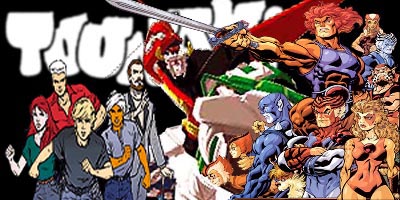 It may sound a bit strange to some, but the best moment of the block was the creation of Toonami block itself.
It may sound a bit strange to some, but the best moment of the block was the creation of Toonami block itself.
Without the creation of the block, I wouldn't have anything to talk about on this site. If those madmen at Ghost Planet Industries weren't in charge of creating a new version of the Super Adventures format, would we feel the same way about the action block of Cartoon Network?
I doubt it. Here's the thing . . . Cartoon Network and GPI created not only a new block of action programming, but also a new environment for Cartoon Network to play in. Free from the restrictions of the normal channel format (in case you didn't know, Toonami's original schedule was show, short, show, short, segment, show, with the middle show starting at 15 to the hour), Toonami had an open environment where they could air custom videos, reviews, and words of wisdom from time to time. The block itself was an experiment in practice, perhaps the only free-reign block on Cartoon Network. Toonami was the laboratory where they tested things they could put on the network later on. Heck, the custom videos, which did used to be a part of Cartoon Network's Morning Crew show, got reimagined on Toonami and later returned to the regular Cartoon Network lineup in the form of Quickies and, in an even more experimental form, Shorties. Three years after Toonami premiered, Toonami aired Cartoon Network's first TV-PG programming, a practice which they expanded on with the creation of Ghost Planet Industries' (now Williams Street Productions) second block, Adult Swim. In April 2004, Toonami and its young sibling block Miguzi both experimented with the commercial format that became official by June of that year.
Toonami also helped solidify the Japanese animation industry in the United States and perhaps North America as a whole. Sure, it wasn't evidenced in the first year, but Toonami became a standard of sorts of quality animation throughout the years, and most anime titles that aired on Toonami became highly-watched properties that extended to merchandising and book sales. From 2005 to today, the highest-selling comic in North America is Naruto, a show that's currently the flagship property of the block. If it wasn't for Toonami, there wouldn't be an Adult Swim nor a Miguzi (though Miguzi ended in the summer of 2007). FUNimation, Viz, and Geneon wouldn't be as big as they are today (well, maybe not Geneon, unfortunately), and Bandai would still be only known as the toymakers behind Power Rangers and Tamagotchi. There wouldn't blocks like Biotix in Canada or an influx of imitators like Fox Family's Made in Japan, Nickelodeon's SLAM, or Toon Disney's Jetix.
To say that the creation of Toonami was revolutionary is an understatement. The launch of Toonami is considered one of the block's greatest moments.

